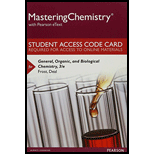
Concept explainers
a.
To determine:
The atoms do the black spheres in the ball and stick models represent.
Introduction:
On a paper the organic molecules can be represented by four types; a single molecule can be represented by, condensed structure, Lewis structure, ball stick model, and skeletal formula. The ball-and-stick model represents the molecular structure in three dimensional; atoms are represented as spheres and bonds represented as cylinders.
b.
To determine:
The two atoms do the red sphere and the small gray sphere to the right of it represent.
Introduction:
On a paper the organic molecules can be represented by four types; a single molecule can be represented by, condensed structure, Lewis structure, ball stick model, and skeletal formula. The ball-and-stick model represents the molecular structure in three dimensional; atoms are represented as spheres and bonds represented as cylinders.
Want to see the full answer?
Check out a sample textbook solution
Chapter 4 Solutions
Mastering Chemistry with Pearson eText -- Standalone Access Card -- for General, Organic, and Biological Chemistry (3rd Edition)
- Benedict’s solution can be used to distinguish between: a) fructose and glucose b) maltose and lactose c) maltose and amylose d) amylose and amylopectinarrow_forwardThe fact that sweet-tasting carbohydrates like table sugar are also high in calories has prompted the development of sweet, low-calorie alternatives, (a) Identify the functional groups in aspartame, the artificial sweetener in Equal, (b) Label all of the sites that can hydrogen bond to the oxygen atom of water, (c) Label all of the sites that can hydrogen bond with a hydrogen atom of water.arrow_forwardTo Which category does the molecule below belong? A) Protein B) alcohol C) aromatic hydrocarbons D) carbohydrate PLEASE HELP ME UNDERSTAND PLEASE PLEASE There is an image attached!arrow_forward
- Classify the following alcohols as primary, secondary, or tertiary: a. b. CH3CH2CH2CH2OH c.arrow_forwardFatty acids are carboxylic acids that have long hydrocarbon chains attached to a carboxylate group. How does a saturated fatty acid differ from an unsaturated fatty acid? How are they similar?arrow_forward
 Introductory Chemistry: An Active Learning Approa...ChemistryISBN:9781305079250Author:Mark S. Cracolice, Ed PetersPublisher:Cengage Learning
Introductory Chemistry: An Active Learning Approa...ChemistryISBN:9781305079250Author:Mark S. Cracolice, Ed PetersPublisher:Cengage Learning Introductory Chemistry: A FoundationChemistryISBN:9781337399425Author:Steven S. Zumdahl, Donald J. DeCostePublisher:Cengage Learning
Introductory Chemistry: A FoundationChemistryISBN:9781337399425Author:Steven S. Zumdahl, Donald J. DeCostePublisher:Cengage Learning Chemistry for Today: General, Organic, and Bioche...ChemistryISBN:9781305960060Author:Spencer L. Seager, Michael R. Slabaugh, Maren S. HansenPublisher:Cengage Learning
Chemistry for Today: General, Organic, and Bioche...ChemistryISBN:9781305960060Author:Spencer L. Seager, Michael R. Slabaugh, Maren S. HansenPublisher:Cengage Learning Chemistry by OpenStax (2015-05-04)ChemistryISBN:9781938168390Author:Klaus Theopold, Richard H Langley, Paul Flowers, William R. Robinson, Mark BlaserPublisher:OpenStax
Chemistry by OpenStax (2015-05-04)ChemistryISBN:9781938168390Author:Klaus Theopold, Richard H Langley, Paul Flowers, William R. Robinson, Mark BlaserPublisher:OpenStax Chemistry: Principles and PracticeChemistryISBN:9780534420123Author:Daniel L. Reger, Scott R. Goode, David W. Ball, Edward MercerPublisher:Cengage Learning
Chemistry: Principles and PracticeChemistryISBN:9780534420123Author:Daniel L. Reger, Scott R. Goode, David W. Ball, Edward MercerPublisher:Cengage Learning Chemistry & Chemical ReactivityChemistryISBN:9781133949640Author:John C. Kotz, Paul M. Treichel, John Townsend, David TreichelPublisher:Cengage Learning
Chemistry & Chemical ReactivityChemistryISBN:9781133949640Author:John C. Kotz, Paul M. Treichel, John Townsend, David TreichelPublisher:Cengage Learning





